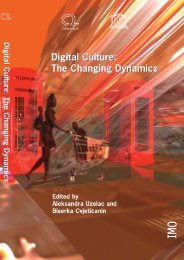free download in pdf format - Culturelink Network
free download in pdf format - Culturelink Network
free download in pdf format - Culturelink Network
You also want an ePaper? Increase the reach of your titles
YUMPU automatically turns print PDFs into web optimized ePapers that Google loves.
Identity construction <strong>in</strong> the Balkan region - Austrian <strong>in</strong>terests<br />
and <strong>in</strong>volvement <strong>in</strong> a historical perspective<br />
Andrea Komlosy and Hannes Hofb auer<br />
Abstract<br />
Aft er the dissolution and destruction of Yugoslavia with its historical cut-off po<strong>in</strong>t of 1991<br />
and the successive wars throughout the 1990s , new identities are be<strong>in</strong>g sought <strong>in</strong> the region.<br />
Like every cultural and social process this identity construction is exposed to economic and<br />
(geo) political rationalities and pressures. Th ey come from <strong>in</strong>side as well as from outside. In<br />
a historical perspective this can be seen clearer than from a contemporary view.<br />
Already the nam<strong>in</strong>g of the region refl ects the <strong>in</strong>teraction of <strong>in</strong>ternal and external<br />
factors <strong>in</strong> a (post)transitional situation. Th erefore at the beg<strong>in</strong>n<strong>in</strong>g we discuss the terms<br />
“Balkan” and “Southeastern Europe”.<br />
Th e Austrian advance <strong>in</strong> the region went hand <strong>in</strong> hand with the step-by-step withdrawal<br />
of the Ottoman Empire. Th e late 19th century with the Berl<strong>in</strong> Congress (1878) and the<br />
end of the adm<strong>in</strong>istrative particularity of the Vojna Kraj<strong>in</strong>a (1881) mark a new period.<br />
We study the history of Austrian <strong>in</strong>terests <strong>in</strong> the Balkans s<strong>in</strong>ce then. Th e Vidovdan of<br />
1914 and its geopolitical outcome put an end to Vienna’s advances, at least for a while.<br />
In 1941 the Austrians came aga<strong>in</strong>, this time <strong>in</strong> German uniforms help<strong>in</strong>g to divide the<br />
region <strong>in</strong>to sections accord<strong>in</strong>g to the needs of the “Grossraum”. Fift y years later (1991),<br />
aft er the remnants of post-Tito Yugoslavia fell apart, it was Austrian politics and economic<br />
<strong>in</strong>terests which heavily <strong>in</strong>tervened <strong>in</strong> the region, thereby accelerat<strong>in</strong>g the dis<strong>in</strong>tegration.<br />
We discuss the background, personalities and importance of this development.<br />
Keywords: Balkan region, Austria, identity construction, historical representations<br />
11



